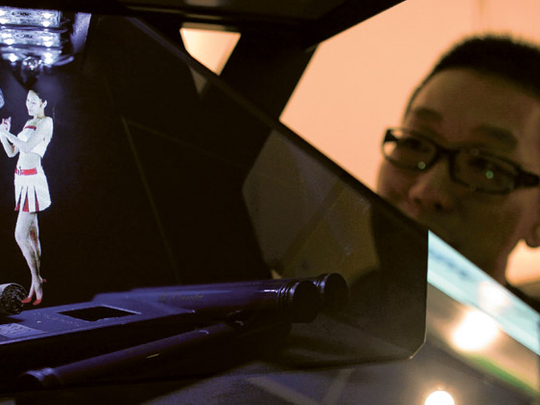
Dubai: Looking for something new and quirky that will catch the public eye for your product placement?
Make way for HoloAD, a new portable device that could someday replace television as the family-gathering medium in our homes.
Tucked away in a nondescript booth in a less-visited corner of Gitex Technology Week conference last week, a small Taiwan technical firm was quietly making its first appearance at Gitex to launch in the Middle East its attention-grabbing device which uses holographic-type technology.
Similar on a much smaller scale to the fictional holodeck in StarTrek Next Generation, the moving video images, downloaded from a simple USB which sticks into the HoloAD machine, looked so real it was almost as if you could pick them up and cup them in your hand.
In one of two HoloAD devices on display, a series of miniature dancing women proved highly popular, drawing praise from grinning, dark-suited businessmen chatting up a storm at the HoloAd booth.
Research
Jason Chang, Product Manager for HaloAD, worked on the original research and development project with designer and manufacturer Innovision Labs located in Taipei. "This is the first time we've been to the Middle East; this is the launch here of our new HoloAD," he told Gulf News. "Reaction has been very good. Those who have seen it are telling us that it is very alive, very lifelike."
Chang readily admitted that there was nothing earth-shattering about demonstrating a moving holographic image. He said the difference with HoloAD was that it didn't require elaborate, costly laser-emitting equipment to project the image.
At a cost of Dh18,364 ($5,000) the basic model for HoloAD, which is 35cm tall and 43cm wide, is completely portable and weighs only 16kg.
And you don't need an MIT electrical engineering degree to download images and get them up and running, Chang was quick to point out. "This is big selling point for HoloAD. It is portable and it is very easy to use. It's simple plug-and-play. You insert the USB stick and the video is converted in the machine. Within a minute or two, you unplug the USB and the video is instantly converted into a moving three-dimensional image that hangs in the air," he said.
The video is played in "live runtime mode" and can be updated or changed with the simple insertion of a USB stick, he added.
Chang said that downloaded images were split by the machine software into three separate images, which were then beamed through prism-like glass to combine the images into one.
Simplicity of use has been a major reason behind strong sales, he said, since the HoloAD was launched in late 2009.
The HoloAD had been designed primarily as a way for advertisers, retailers and those involved in the exhibition industry to immediately capture public interest with capitivating moving images, he said.
To display simple products, Chang said that companies could film objects or people they'd like to display in the HoloAd and save the image to a USB stick to be transferred.
The company said using a moving holographic-like image to capture people's attention worked better than posters or television.
The new HoloAD units are available in the Middle East via distributors Hitek Electronics in Dubai, Chang said.












